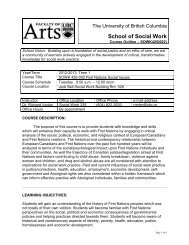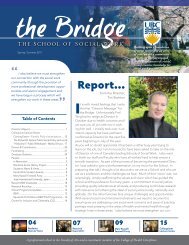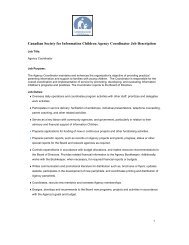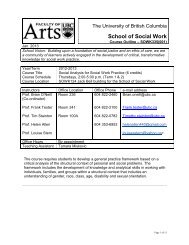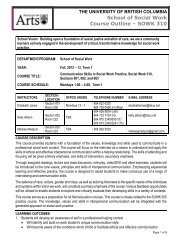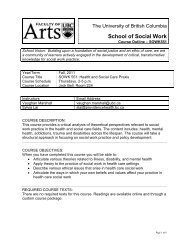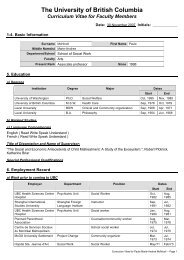Equity Case Studies Report - School of Social Work - University of ...
Equity Case Studies Report - School of Social Work - University of ...
Equity Case Studies Report - School of Social Work - University of ...
You also want an ePaper? Increase the reach of your titles
YUMPU automatically turns print PDFs into web optimized ePapers that Google loves.
UBC school <strong>of</strong> social work equity and diversity strategic plan: A compilation <strong>of</strong> case studies 82<br />
creating activities to prepare students for the foreseeable experience <strong>of</strong> tensions. Williams<br />
(2003) posits that this process should include a discussion about ‘safety’ and ‘comfort’. The<br />
issue and concept <strong>of</strong> ‘safety’ and ‘comfort’ arose during interviews with other <strong>Social</strong> <strong>Work</strong><br />
programs. Part <strong>of</strong> these <strong>School</strong>s/Faculties <strong>of</strong> <strong>Social</strong> <strong>Work</strong>’s process, and <strong>of</strong>ten challenges, in<br />
providing classroom climates that promoted equity, revolved around the questions: what does<br />
‘safety’ look like, and safety for who? Without conversations about these issues, safety<br />
continues to be defined as comfort only for students, and teachers, with dominant identities.<br />
Furthermore, these experiences <strong>of</strong> ‘safety’ greatly differ depending on individuals’ social<br />
location, history, and experiences. Discussions about ‘safety’ need to include what this looks<br />
like for both dominant and minoritized groups.<br />
As an example, the <strong>School</strong> <strong>of</strong> <strong>Social</strong> <strong>Work</strong> at Dalhousie has undergone a process <strong>of</strong><br />
acknowledging how institutional policies and practices in multiple areas – such as student access,<br />
curriculum, pedagogy, scholarship, program delivery, staff recruitment and development, and<br />
governance and leadership – all contribute to the overall institutional climate. As such, there is a<br />
greater chance <strong>of</strong> improving climate by creating changes in policy and practice in each <strong>of</strong> the<br />
areas, opposed to making specific efforts within any one area. The <strong>School</strong> employed a myriad <strong>of</strong><br />
strategies to address each <strong>of</strong> these areas, in turn, impacting the overall climate <strong>of</strong> the school. The<br />
actions that the faculty and staff took to increase equity included course design and investment in<br />
equity-related resource materials; taking initiative to learn about the experiences <strong>of</strong> minoritized<br />
groups instead <strong>of</strong> “waiting for the minority to educate the majority” (MacDonald et al., 2003, p.<br />
483); all faculty members taking equal responsibility and expectations in teaching about diversity<br />
rather than expecting it to always be undertaken by minoritized faculty members; and<br />
“supporting and defending colleagues when they complain <strong>of</strong> harassment or discrimination.”



